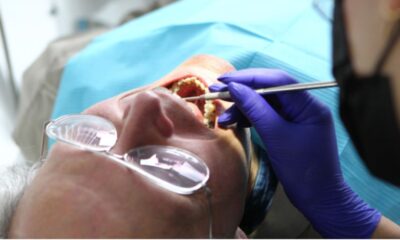HEALTH
Practical Tips for Maintaining Oral Health for the Whole Family

Keep your teeth healthy by regularly flossing, brushing with fluoride toothpaste twice daily, and making regular dental appointments. Promote a nutritious diet free of sugary snacks, drink lots of water, and use mouthguards when playing sports. Instilling these habits early helps ensure good dental health for the whole family.
The Importance of Family Dental Care
Although it is sometimes disregarded, oral health is crucial to general well-being. Caring for your teeth and gums involves more than just achieving a white smile; it consists of maintaining your entire family’s health. Discover Essential Oral Health Tips to help every family member maintain good oral health.
Good dental hygiene is essential for everyone, including older people. Developing these habits early and maintaining them throughout life can prevent many dental problems, such as cavities, gum disease, and bad breath, ensuring a healthier lifestyle overall. Let’s look at some doable actions you may take to protect your family’s oral health.
Daily Habits for Healthy Teeth
Developing good daily habits can significantly enhance your oral health. Brushing two times a day, flossing regularly, and using mouthwash with antiseptic properties are easy but powerful ways to maintain oral health. These practices can help prevent cavities, gum disease, and plaque buildup. For personalized advice, consider consulting with the experts at Champaign Dental Group.
Brushing and Flossing
Employ toothpaste containing fluoride and brush your teeth twice daily for at least two minutes. Reach all areas, especially the rear molars, as these are familiar places for food particles to become stuck. By removing food debris and plaque in hard-to-reach areas, flossing decreases your chances of developing gum disease and cavities. The American Dental Association recommends flossing at least once a day.
Encouraging Children
Encourage children to adopt these routines early. Make brushing fun by letting them choose their toothbrush and toothpaste, and consider using a reward system to build these habits. Educational videos and storybooks about dental care can also be great tools to engage young minds and make brushing time enjoyable.
The Role of Diet in Oral Health
What you eat has a direct impact on your oral health. Limiting sugar-filled foods and beverages can prevent dental decay and cavities. Consuming it helps your oral tissues resist infection, strengthens your teeth and gums, and helps your gums and teeth stay healthier.
Foods That Promote Oral Health
- Dairy Products: Rich in calcium, foods such as milk, cheese, and yogurt help build strong teeth and bones.
- Crunchy Vegetables: Carrots and celery enhance oral health by promoting saliva production. Saliva neutralizes acids and removes food debris to clean teeth and gums.
- Water: Keeps saliva levels stable and aids in washing away food particles, which are both essential for mouth protection. Fluoridated water also helps to strengthen tooth enamel.
Importance of Regular Dental Check-Ups
Visiting the dentist regularly can catch potential issues before they become serious problems. Regular check-ups and cleanings help maintain oral health and can even detect early signs of conditions like oral cancer. Scheduling dental visits every six months is a good rule of thumb, although some individuals may need more frequent check-ups based on their dental health needs.
The American Dental Association says these routine appointments include a deep clean, checking for cavities, and assessing gum health. Dentists can also provide tailored advice on maintaining oral hygiene and address concerns ranging from bad breath to chronic dry mouth.
Leveraging Technology for Dental Care
Modern technology offers various tools that can assist in maintaining oral health. Electric toothbrushes, dental apps, and intelligent brushing devices can track your habits and provide real-time feedback. Such advancements make maintaining oral hygiene more accessible and more efficient, especially for tech-savvy individuals.
Electric Toothbrushes
Studies suggest electric toothbrushes can remove plaque more efficiently than manual ones, reducing the risk of cavities and gum disease. These brushes often come with timers to ensure you brush for the recommended two minutes and have different modes for sensitive teeth or gum care.
Educational Resources
Educational resources such as Colgate’s Children’s Oral Care Guide offer valuable information tailored for different age groups. These resources can help you understand your family’s specific dental needs and how to address them effectively. Online platforms, dental apps, and educational videos can impart significant knowledge and make learning about oral care engaging and informative.
Special Tips for Children’s Oral Health
Kids require different dental treatments than grown-ups do. Parents should teach proper brushing techniques and ensure their children get enough fluoride. As soon as the first tooth erupts, routine dental appointments should begin to create a dental home for continuing preventative treatment.
Fluoride Use
Fluoride protects teeth by strengthening the enamel’s ability to defend against acid attacks from plaque, bacteria, sugars, and starches, thus preventing tooth decay. Ensure your child uses a pea-sized amount of fluoride toothpaste and avoids swallowing it. Fluoride varnish treatments at dental visits protect children’s teeth, especially those prone to cavities.
Oral Health Guidance for Seniors
As people age, their dental needs change. Seniors may require more frequent check-ups and specialized treatments to manage issues such as dry mouth and gum disease. Medications, lack of dental care, and underlying health issues can aggravate these conditions.
Common Issues
Seniors often deal with conditions like dry mouth, which can increase the risk of decay. Maintaining hydration and using mouthwashes designed for dry mouth can help alleviate this issue. Denture care is another important aspect; keeping dentures clean and fitting properly can prevent sores and infections.
Routine Care
Using fluoride toothpaste and maintaining an excellent oral hygiene routine is essential for preserving dental health in older adults. Frequent dental check-ups enable monitoring of oral health changes, facilitating prompt interventions. Eating a nutrient-rich diet and avoiding tobacco contribute to healthier teeth and gums.
Final Thoughts
Taking care of one’s oral health involves dedication and regular attention from the entire family. By instilling good habits, eating a balanced diet, and leveraging modern technology, you can ensure every family member enjoys a healthy smile for years. Understanding the unique needs of each age group—from toddlers to seniors—ensures that dental care is comprehensive and practical.
HEALTH
The Role of Community in Veteran Health and Wellness

Did you know that a strong community connection can play a transformative role in the health and wellness of our veterans? In recent years, studies have shown that social integration significantly boosts mental health and overall well-being, especially for those who have served in the military.
Veterans often face unique challenges, and having a supportive community can be a crucial factor in their recovery and sustained health. This article explores the vital importance of a community in veteran health and how senior living options can enhance their overall quality of life. Keep on reading.
The Importance of Community in Veteran Well-Being
For veterans transitioning back into civilian life, the shift can often feel overwhelming. Many struggle with feelings of isolation and alienation from those who haven’t shared similar experiences. This is where a sense of community becomes essential.
A supportive network helps veterans feel connected and valued. In senior living environments, fostering a community spirit can lead to:
A Sense of Belonging
Veterans often feel better when they know others share their past. Living with peers who understand can make them feel safe. This helps build real friendships and trust.
Improved Mental Health
Being around others can ease sad or anxious thoughts. Talking, laughing, and sharing stories helps the mind. These small moments lift spirits each day.
Physical Health Benefits
Group activities like walks or games keep the body moving. Staying active with others can be more fun. It helps veterans stay strong and feel better.
Easy Access to Resources
A strong group can guide members to helpful tools. It’s easier to ask for help when others understand. Veterans find what they need without feeling lost.
How Senior Living Enhances Social Connections
Many places where seniors live are made to feel like a strong community. Some have special programs just for veterans. These programs help them feel supported and connected with others.
There are group trips, fitness classes, and other fun things planned for veterans. These keep them busy, happy, and moving. It also helps them meet people who understand them.
Some places also give extra care for mental health. Veterans can talk to people who know about things like PTSD. Being around others with similar stories can help them feel less alone.
Building Supportive Care Frameworks
Supportive care is more than just meeting physical needs; it’s about holistic wellness that encompasses emotional, mental, and social aspects. Within a community-focused approach, veterans can tap into:
- Peer support groups
- Integrative wellness programs
- Access to healthcare
The Unique Proposition of Community-Focused Senior Living
Choosing a senior living arrangement that emphasizes community focus provides veterans with the unique opportunity to enhance their quality of life. Not only can they maintain independence, but they can also engage in a variety of activities designed to foster relationships and an active lifestyle.
Facilities that prioritize a community focus in veteran health often include programming tailored specifically for them. They offer more than just a place to live. Veteran programs for seniors create a supportive atmosphere promoting veteran wellness through engagement, shared experiences, and friendship.
Invest in Your Health and Well-Being Today!
If you or a loved one is a veteran looking for a welcoming community, consider exploring options that offer comprehensive support and a vibrant community in veteran life. With a focus on wellness and connection, you can conquer the challenges of daily living and thrive among peers who understand and appreciate your journey. Your health and well-being deserve a community that cares.
For more related topics, check out the rest of our blog!
HEALTH
How Cannabis Extracts are Redefining Medical Applications

How can one plant help with so many health needs?
Cannabis extracts are now used in new ways to treat different medical problems. These extracts come in forms like oils, drops, and pills. Many people use them to feel better without strong drugs.
Doctors and patients are starting to see the value of these products. They are easy to use and made with care. If you’re looking for new ways to feel better, cannabis extracts might be worth a try. Want to learn more about how they work and how they can help? Keep reading!
Managing Pain
Many people deal with pain each day, and finding safe ways to manage it matters. Cannabis extracts are giving new hope by offering support for pain that doesn’t always respond to common treatments.
These extracts may help with joint pain, nerve pain, and pain from injuries. They work by interacting with the body’s systems in a natural way. Unlike some strong drugs, they are less likely to cause harm with long use.
Doctors are now looking at these extracts as a helpful tool for people with ongoing pain. As more studies are done, more is learned about their benefits. To stay informed about growing options for care, reading articles like these can help guide smart choices.
Helping with Sleep
Trouble falling asleep or staying asleep can affect daily life. Cannabis extracts are now being used to support better sleep by helping the body relax at night. Some people say they fall asleep faster and wake up less often.
These extracts may work by calming certain parts of the brain that stay active during rest. Many users prefer them over common sleep aids because they feel more natural. They are often taken as drops or capsules before bedtime.
People who have tried other sleep methods without success are now turning to this option. As more is learned, cannabis extracts may become a trusted part of nightly routines. For those hoping to wake up feeling more rested, they could be a step toward better sleep.
Easing Anxiety and Stress
Busy days and constant pressure can lead to feeling overwhelmed. Cannabis extracts are now being used to help ease anxiety and lower stress levels. Some people say they feel calmer and more balanced after using them.
These extracts may work by helping the brain respond better to stress signals. They are often taken in small amounts during the day and may support a more peaceful state of mind in daily life.
Supporting Appetite and Nausea Relief
Feeling sick or not wanting to eat can make recovery harder. Cannabis extracts are now being used to help reduce nausea and improve appetite. This can be helpful for people going through treatments that make eating difficult.
The extracts may work by calming the stomach and making food seem more appealing. They are often taken in small doses and come in easy-to-use forms. For some, they offer simple support during times of low appetite or queasiness.
Exploring New Paths with Cannabis Extracts
Cannabis extracts are opening new doors in medical care, offering support in ways that were once hard to find. From easing daily struggles to helping with serious health challenges, these extracts are changing how treatment can look and feel.
Their growing use shows how natural options are becoming part of trusted care plans. As research continues, more people may find comfort and balance through these products. Exploring new paths with cannabis extracts in modern care shows how far healing can go.
Did you find this article helpful? Visit our website for more awesome content like this.
HEALTH
Understanding the Aesthetic and Health Benefits of Blepharoplasty

Have you ever looked in the mirror and wished for a change? If tired eyes are affecting how others see you, blepharoplasty could help. This procedure offers a way to refresh your look and boost your confidence.
Many people feel self-conscious about their eyes. They may be a bit droopy or puffy, which can age the face. Blepharoplasty is designed to address these concerns, allowing you to feel confident about your appearance again.
In this article, we will discuss the aesthetic and health benefits of blepharoplasty. Read more!
Removing Excess Skin for Clearer Vision
Excess eyelid skin can droop over the eyes and block your sight. This often makes daily tasks like reading or driving harder than they should be. Removing this skin can help restore a full, clear field of vision.
One of the key blepharoplasty benefits is the improvement in both appearance and function. Patients often feel more alert and look more refreshed after surgery. With better vision and comfort, daily life becomes easier and more enjoyable.
Reducing Eye Strain and Fatigue..
Eye strain is a common issue for many people today. Stress and daily demands can leave your eyes feeling tired and overworked. Blepharoplasty can significantly reduce this fatigue and refresh your overall appearance.
After the procedure, individuals often report that their eyes feel lighter and less strained. This new comfort might allow for longer periods of focus on tasks. Feeling less tired can also improve your mood and boost your energy levels.
Correcting Puffy or Droopy Eyelids
Puffy or droopy eyelids can impact both your looks and comfort. People often choose blepharoplasty to address these issues. This transformation brings a more alert and youthful gaze.
Your eyes are a vital part of your expression. Correcting droopiness can make them appear larger and brighter. Increased confidence follows, as many feel more attractive and engaged with the world.
Enhancing Facial Balance and Symmetry
Facial symmetry plays a significant role in perceived beauty. Blepharoplasty helps align your eyes and eyelids, promoting a more harmonious look. This balance enhances facial aesthetics dramatically.
A proper alignment may boost your overall self-esteem. Feeling more balanced and beautiful can change how you approach social situations. Many report newfound confidence after achieving this desired symmetry.
Improving Self-Image and Emotional Well-Being
When you look good, you often feel good too. The mental clarity that comes with improved appearance is powerful. Many experience enhanced self-image after undergoing Blepharoplasty.
People often report feeling more capable in social settings and daily interactions. An improved self-image can lead to better opportunities. Embracing self-care through surgery can also be a pivotal moment for many.
The Transformative Power of Blepharoplasty
Blepharoplasty is more than just a physical change; it can greatly enhance your quality of life. Addressing common eyelid concerns can boost your self-confidence and improve visual comfort. Consider this procedure if you’re looking to revitalize your appearance.
Connecting with a professional can help you understand how Blepharoplasty might work for you. Take the first step towards refreshed eyes and a renewed spirit. You deserve to feel confident in how you look every day.
Did this article help you? Browse our blog for more interesting topics.
-

 HEALTH1 year ago
HEALTH1 year agoIntegrating Semaglutide into Your Weight Loss Plan: A Practical Guide
-

 HOME IMPROVEMENT1 year ago
HOME IMPROVEMENT1 year agoHow to Choose the Perfect Neutral Area Rug for Every Room
-

 LAW1 year ago
LAW1 year agoPost-Divorce Considerations in California: Modifications and Long-Term Planning
-

 LAW1 year ago
LAW1 year agoTeenage Drivers and Car Accidents in California: Risks and Parental Liability
-

 CONSTRUCTION1 year ago
CONSTRUCTION1 year agoConstruction Site Safety Regulations in New York and Your Rights as a Worker
-

 FINANCE1 year ago
FINANCE1 year agoDigital Asset Management in Florida Estate Planning
-

 LAW1 year ago
LAW1 year agoKentucky’s School Football: Concussions, Injuries, and Legal Options
-

 LAW1 year ago
LAW1 year agoGang Activity and Criminal Charges in CA: Protecting Your Rights


